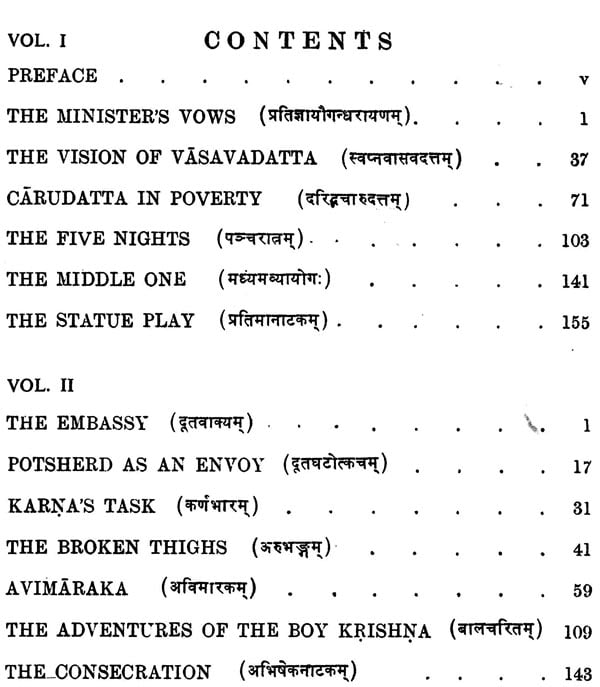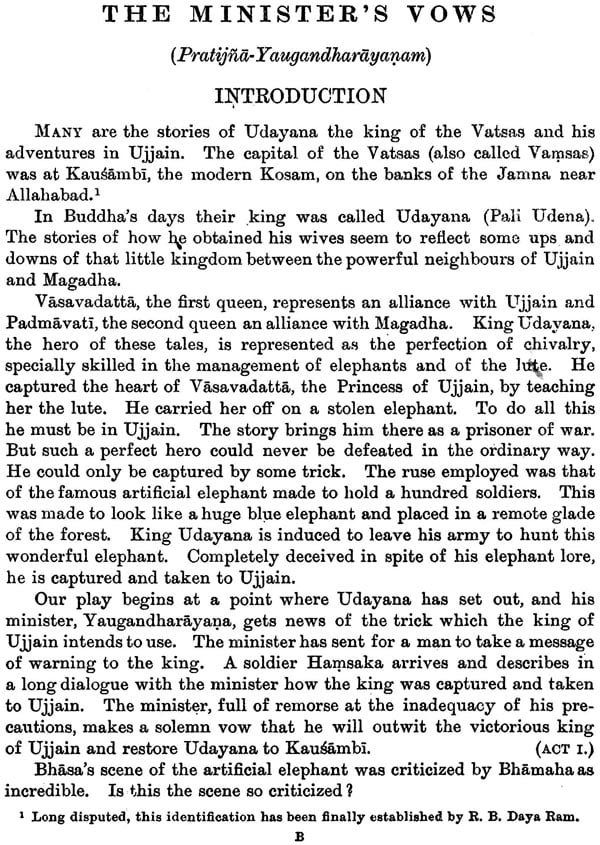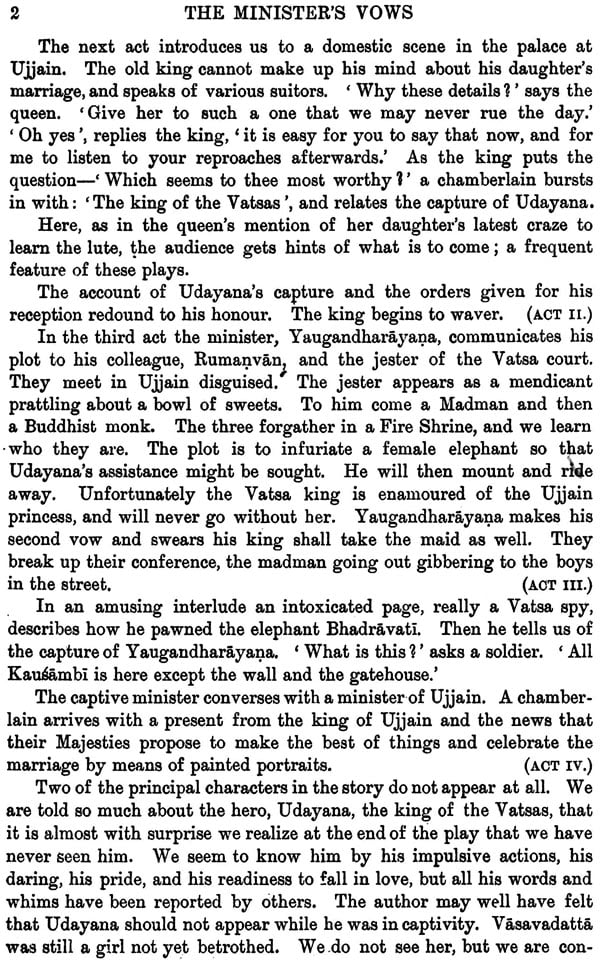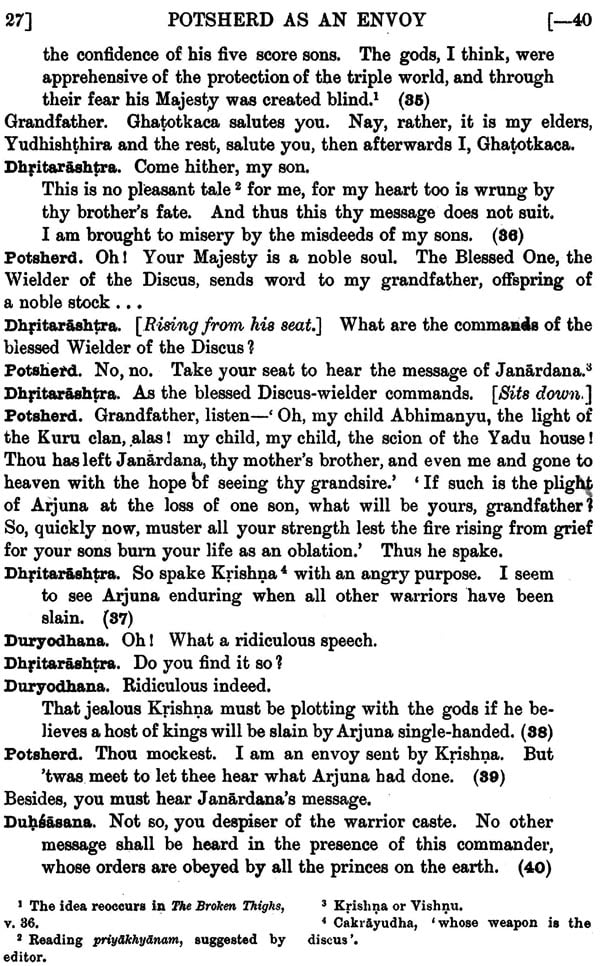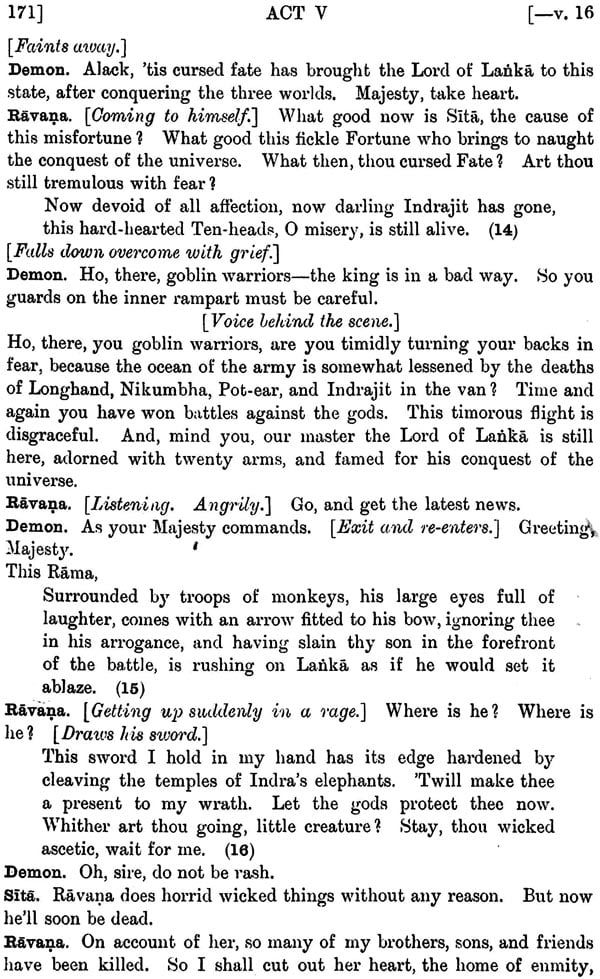
Thirteen Plays of Bhasa
Book Specification
| Item Code: | NAT698 |
| Author: | A.C. Woolner and Lakshman Sarup |
| Publisher: | MOTILAL BANARSIDASS PUBLISHERS PVT. LTD. |
| Language: | ENGLISH |
| Edition: | 2015 |
| ISBN: | 9788120809086 |
| Pages: | 391 |
| Cover: | HARDCOVER |
| Other Details | 9.00 X 6.00 inch |
| Weight | 500 gm |
Book Description
This translation is of thirteen Sanskrit plays discovered in South India by the late Pandit Ganapati Sastri and edited by him in the Trivandrum Sanskrit Series. It comprises the following tides : 1. Pratijiinyaugandharayarna, 2. Svapnavrisavadattet, 3. Caruclatta, 4. Panacaratra, 5. Madhyamavyayoga, 6. Pratima-nataka, 7. Dutavakya, 8. Dutaghatotkaca, 9. Karnabhara, 10.Urubhanga, 11. Avimaraka, 12. Balacarita, and 13. Abhiseka. S'astr1attributed all the thirteen plays to Bhasa and the prevailing opinion of the scholars is in agreement with him, though the available evidence is not conclusive and so the question still remains open. The translation was done by two eminent Sanskrit scholars. It was published as early as 1930 and a reprint is now issued in view of a persistent demand of scholars.
Winternitz's major work was Geschichte der Indischen Literature (History of Indian Literature). The first volume was published in two part in 1905 and 1908. It dealt with Vedic literature, the epics and Puranas. The second volume on Buddhist and Jain literature appeared in two parts, in 1913 and 1920. In the last volume, Kavya literature and scientific literature found a representation. The present English Translation is based on the original German work and has been revised in the light of further researches on the subject by different scholars in India and elsewhere. This is divided into two sections. Section I relates to Veda (the Four Samhitas), Brahmanas, Aranyakas, Upanisads, Vedangas and the literature of the Ritual Section II relates to the study of two great Epics of India-the Ramayana and the Mahabharata. It carries out a general survey of the Puranic literature, and provides ample information about the Tantras too.
It contains two section viz. Section III and Section IV relating to Buddhism and Jainism literature respectively.
It covers the history of Classical Sanskrit literature and the Scientific literature with its characteristics, grammar, lexicography, philosophy, dharmasastra, architecture, sangitagastra, Kamagastra, ayurveda, astronomy, astrology and mathematics and also has an appendix.
THIS Translation is of thirteen Sanskrit plays discovered in South India by the late Pandit Ganapati Sastri and edited by him in the Trivandrum Sanskrit Series.
Neither in the first MS. found, which contains twelve of the plays and portion of another, nor in other MSS. which contain single plays, is the author's name recorded.
Pandit Ganapati Sastri attributed all thirteen plays to Bhasa, a famous dramatist earlier than Kalidasa. Some verses are ascribed to Bhasa by medieval anthologies, but only ten with unanimity. We are told that he composed a Svapna-Vasavadattam (his best play), and that in another play the device of the wooden elephant was used. Characteristic features of his work are described by Mina, and other poets evidently held him in high estimation. One or two verses from his plays are quoted by writers on poetics. Otherwise the text of Bhasa's numerous plays had completely disappeared.
The learned editor of the Trivandrum plays found that they contained a Svapna-Vasavadattam (the best play in the collection), and, in the Pratijii0,-YaugandharayRiam, a scene dealing with the wooden elephant. He noticed also certain peculiarities in the technique of the plays which he regarded as signs of antiquity.
All these points confirmed him in the opinion that Bhasa was the author. At first this conclusion was generally accepted both in India and in the West. Later on doubts were expressed. It was found that some of the special features which had been regarded as evidence of an early date (prior to Kalidasa) were not peculiar to these plays. They occur with some modifications in other South Indian MSS. of plays as late as the seventh century. The verses ascribed to Bhasa by the anthologies do not occur in the Trivandrum plays. Hence the sceptical school doubted whether any of this collection had been written by Bhasa at all. This is not the place to discuss the evidence, let alone the arguments, in detail. Nevertheless the question is not without interest even for the general reader. If we place the historical Bhasa in the second or third century A. D., and if we can accept this collection of plays as the authentic work of Bhasa, then we have a piece of evidence of great importance for the history of literature and the manner of life it' reflects. If, however, these plays are to be regarded as compositions of the seventh century or later their importance is considerably reduced.
Now the problem may be approached along the lines of three hypotheses.
A. That all thirteen plays are the work of one writer, or at least of one period.
B. That they were written by different authors, perhaps at different periods.
C. That older material has been worked over, and to some extent worked up by a later hand.
A. Nearly all that has been written on the subject implies the first hypothesis. This is common to the most ardent supporters of the Bhasa theory and to those who believe in the latest dates suggested. Dr. Sarup has sought to link up eleven of the thirteen plays by their internal similarities. Now if this hypothesis be reasonable there is one important circumstance to be borne in mind. It can hardly be doubted by any one who has compared the two, line by line and word by word, that the Daridra-Carudattam (incomplete as it is) is earlier than the M•echakatikam.2 Hence on this hypothesis all thirteen plays should be older than The Little Clay Cart.
Of course we do not know the date of The Little Clay Cart, but probably nobody will put it much later than the Gupta period.
Plays that were older than The Little Clay Cart could hardly be contemporary with a farce like the Matta-Vilasa of the seventh century.
B. If, in spite of certain external similarities and internal correspondences, we should assume a diversity of authorship, the claims of each play would have to be considered separately. The Vision of Vasavadatta and The Minister's Vows would then have the strongest claims on the evidence.
The various similarities, however, would make it difficult to suppose the plays belonged to very different periods. So the evidence of the Carrudatta and The Little Clay Cart comes in again.
As a matter of fact few writers have adopted this hypothesis.
C. The third hypothesis is to a certain extent a variant of the first. It is implied in a limited form in what Dr. Sarup suggested about different recensions' in his Introduction to The Vision of Vasavadatta.
Something of the kind is suggested by Dr. F. W. Thomas in his article on the date of the Svapna-Viisavadattam.' As defined above, however, this hypothesis contains the possibility of a much more extensive revision or rewriting than Dr. Sarup, for one, would be ready to admit.
On this hypothesis the problem becomes more complicated. It is no longer a matter of voting pro-Bill-1m or anti-Bhasa once for all. It becomes a question of distinguishing the true Bhasa from the pseudo-Bhasa, not merely play by play, but scene by scene and even verse by verse. Along the lines of this hypo-thesis, we might explain some of the inconsistency of the Prakrit, mingling apparently old and more modern forms. Again, every reader must feel that some of the scenes are very inferior to the best, that some of the verses are flat and of inferior workmanship. The Statue Play has the one striking original scene that gives its name to the play. The later acts, especially the sixth and seventh, are conventional and rather feeble. Have they not been added by a later hand ?
If we ask why the Carta& was not completed by the later hand, the answer is that the existence of The Little Clay Cart made it unnecessary. Moreover it was customary in South India for an acting company to play incomplete plays or even single scenes, as modern schools and colleges often do. Dr. Sarup has a transcript of a MS, in old Malayalam character containing only one act (the third) of the Pratijna-Yaugandharayanam. If that is, an old custom it might account for the preservation of isolated scenes from Bhasa, which could be padded out or completed at a later date. It remains to see whether any linguistic indications coincide with the more subjective judgements of taste.
The translation has been made without prejudice regarding authenticity. One translator has been more sceptical than the other, but we have done our best for every act. The aim has been to represent all that is in the original (excepting a few repeated or redundant words), but to shake off the burden of the Sanskrit sentence just enough to make the dialogue and recited passages tolerable to the general reader.
No attempt has been made to render verses by verse, which would be apt to jingle, but only to suggest the difference between plain prose and recitative, between more dignified Sanskrit and colloquial or dialectic Prakrit.
The best in this kind are but shadows.' We shall be content if our shadow be not too wooden to produce a momentary Illusion.
**Contents and Sample Pages**
